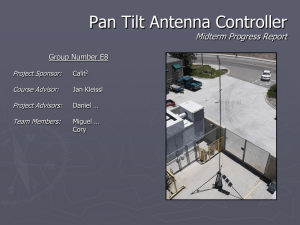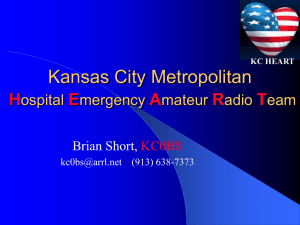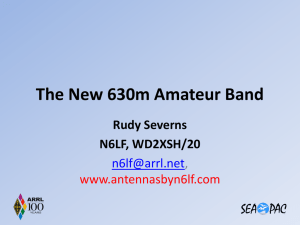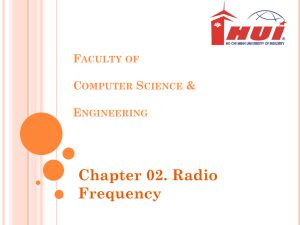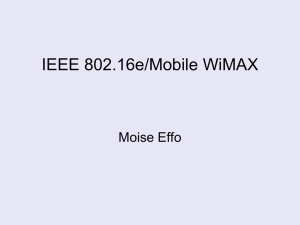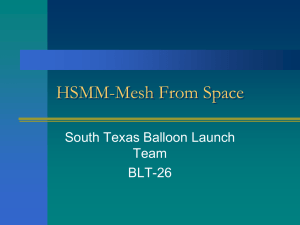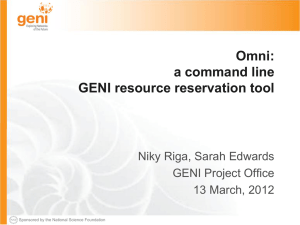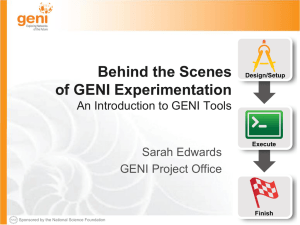Document
advertisement
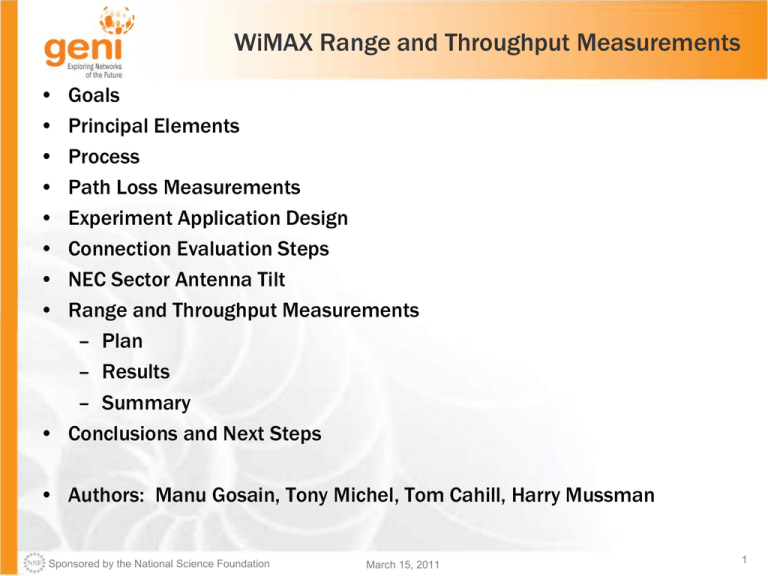
WiMAX Range and Throughput Measurements • • • • • • • • Goals Principal Elements Process Path Loss Measurements Experiment Application Design Connection Evaluation Steps NEC Sector Antenna Tilt Range and Throughput Measurements – Plan – Results – Summary • Conclusions and Next Steps • Authors: Manu Gosain, Tony Michel, Tom Cahill, Harry Mussman Sponsored by the National Science Foundation March 15, 2011 1 Goals • Validate base station installation and configuration process – Provide comprehensive documentation • Design an experiment to evaluate range and throughput – Document for use by other sites in evaluating their expected range and throughput – Later: move to OMF/OML environment • Evaluate range and throughput at BBN site – Compare to known calculations, measurements – Document for use by other sites in estimating their expected range and throughput Sponsored by the National Science Foundation March 15, 2011 2 Principal Elements • Base station kit (BTS) – Utilizing NEC Profile C IDU and ODU • Rooftop antennas – NEC 120deg sector – Commercial omnidirectional • Anritsu spectrum analyzer, for measuring received power • Linux laptop with Intel 6250 WiMAX modem, acting as a mobile station (MS) • BTS servers, including: – ASN GW with WiMAX RF AggMgr (Case 1b) – Test host – I&M host • Experiment application, running in: – MS (measurement script) – Test host (ping and iperf servers) – I&M host (report script) Sponsored by the National Science Foundation March 15, 2011 3 Process • 1) Conduct power measurements using Anritsu spectrum analyzer – Check for presence of Clearwire signal with Anritsu spectrum analyzer • 2) Build and verify experiment application to conduct range and throughput measurements • 3) Decide on best down tilt for NEC sector antenna – Estimate for electrical down tilt: 5deg – Options for mechanical down tilt: 10deg, 6deg, 4deg, 2deg (selected 4deg) • 4) Conduct range and throughput measurements near BBN Technologies location in Cambridge, MA – Focus on line-of-sight, outside only (gives best case) – Keep nominal BTS configuration parameters • Power set to +38dbm, the maximum allowed – Options for base station antenna: • NEC sector base station antenna (at 4deg mechanical down tilt) • Omni-directional base station antenna – Options for Linux laptop mobile station: • Internal Intel 6250 WiMAX modem, and internal antenna • External (USB-connected) 6250, with handheld omni-directional antenna Sponsored by the National Science Foundation March 15, 2011 4 1) Power Measurements • Power measurements using Anritsu spectrum analyzer – Measured with sector antenna, 6deg mechanical tilt – Near antenna: -34dBm – Point 41, 370ft: -59dBm (good signal) – Point, 520ft: -50dBm (good signal) – Point, 1190-ft: -79dBm (edge of coverage) • Presence of Clearwire signal with Anritsu spectrum analyzer – On roof (line of sight): -60dBm – Point 47: -70dBm Sponsored by the National Science Foundation March 15, 2011 5 2) Experiment Application Design Antenna: Mobile Station (MS) 1) NEC sector 2) Omni GREtunnel Dell 1012 Netbook DHCP NEC Base Station (BTS) WiMAX modem/antenna: BTS ODU/IDU 1) USB-connected Intel 6250/external omni 2) internal Intel 6250/ internal 1) Range/throughput experiment script “tstats2”: ASNGW .bbn.dataplane.geni.net “salamis” Test host I&M host “black” 2) WiMAX AggMgr service: Record location Scan/connect/chk RSSI Get IP via DHCP ping sequence iperf sequence Log results Sponsored by the National Science Foundation Monitor GRE tunnels Collect BTS stats, chk RSSI Log results March 15, 2011 public Internet 3) Report script “report”: (manually gather logs from MS and BTS) Process logs Generate location summaries Generate run summary “argos” 4) Test targets: ping iperf 6 Connection Evaluation Steps • Step 1) Verify WiMAX connection occurs – See tunnel setup from BTS log – Check Down Link (DL) RSSI at MS – Check Up Link (UL) RSSI from BTS log • Step 2) Verify MS get IP address via DHCP – Sometimes fails if UL is poor • Step 3) Do a sequence of ping tests between MS and Test Host “argos” – Ping to argos, 10bytes, 10 times; check response within 1sec window; log delays, % responses not within window (lost) – Ping to argos, 108bytes, 10 times; check response within 1sec window; log delays, % responses not within window (lost) – Ping to argos, 1008bytes, 10 times; check response within 1sec window; log delays, % responses not within window (lost) Sponsored by the National Science Foundation March 15, 2011 7 (continued) • Step 4) Do a sequence of iperf tests between MS and Test Host “argos” – Repeat 3 times – Use TCP – Use -d for double connection, separating DL and UL measurements – Throughput in Mb/s calculated from bytes transmitted within 60sec interval – Print throughput in Mb/s to log – TCP parameters: • use Nagle’s algorithm • window size and segment size per OS: 16kB • depth read/write buffer in socket, default: 8kB • max segment size: 1408B (MTU size) - 40B = 1368B – Use of TCP gives conservative result, but typical of many applications Sponsored by the National Science Foundation March 15, 2011 8 3) NEC Sector Antenna Tilt • WiMAX antennas typically have a built-in electrical (down) tilt, and a variable mechanical (down) tilt • Estimate for electrical tilt on NEC sector antenna, per specs: 5deg • Options tried for mechanical (down) tilt: 10deg, 6deg, 4deg, 2deg – Too much down tilt “buries” the signals close to the base station, and shortens range – Too little tilt creates a blank spot near base station – There is always a blank spot very near the base station (and within the building) caused by shadow of the building • Chosen for mechanical tilt: 4deg – Throughput measurements showed range at 4deg to be higher than at 2deg or 6deg Sponsored by the National Science Foundation March 15, 2011 9 4) Measurements Plan • Focus on line-of-sight, outside only (gives best case) – Points 41 through 48, in a straight line at center of 120deg sector pattern – Optional points 1 through 7, in orthogonal direction (with point 7 obstructed by building), to verify expected 360deg omni coverage • Keep nominal BTS configuration parameters – Power set to +38dbm, the maximum allowed • Options for base station antenna: – NEC sector base station antenna (at 4deg mechanical down tilt), approx 90ft high – Omni-directional base station antenna, approx 90ft high – Expect sector to work better than omni antenna within 120deg sector pattern, since has higher gain • Options for Linux laptop mobile station (MS): – External (USB-connected) 6250, with handheld large omni-directional antenna – Internal Intel 6250 WiMAX modem, and internal antenna – Expect large omni antenna to work better than internal antenna – Expect packet loss and throughput to vary from moment-to-moment, due to MS position and multi-path propagation Sponsored by the National Science Foundation March 15, 2011 10 (continued) • For each option combination: – A) BS sector, MS omni antennas – B) BS sector, MS internal antennas – C) BS omni, MS omni antennas – D) BS omni, MS internal antennas • For each point: – 41 – 48 – option for C): 41 – 48 and 1 – 7 • Plot vs distance (mi) from base station to mobile station: – DL RSSI (db) – UL RSSI (db) – 1008byte pings, the % of responses not within window (lost) – DL iperf throughput, min and max over three attempts (Mb/s) – UL iperf throughput, min and max over three attempts (Mb/s) Sponsored by the National Science Foundation March 15, 2011 11 Neighborhood of BBN Technologies, Cambridge, MA Sponsored by the National Science Foundation March 15, 2011 12 Photo of BBN base station and Concord Ave measurement points 41 - 48 BBN Base Station 0 41 42 43 44 45 46 47 48 Sponsored by the National Science Foundation March 15, 2011 0 (0 mi, 90 ft up) BBN Base Station Antenna 41 (0.058 mi) Center Parking Lot 42 (0.085 mi) Social Security Entrance 43 (0.090 mi) NE FawcettConcord 44 (0.097 mi) SE FawcettConcord 45 (0.153 mi) T (Bus) Stop 46 (0.200 mi) S WheelerConcord 47 (0.221 mi) West edge rotary 48 (0.254 mi) East edge rotary 13 Photo of BBN base station and Fawcett St measurement points 1 - 7 7 6 5 4 3 BBN Base Station 0 2 1 0 (0 mi, 90 ft up) BBN Base Station Antenna 1 (0.040 mi) Parking Lot 2 (0.080 mi) Fawcett St 3 (0.110 mi) Fawcett St 4 (0.140 mi) Fawcett St 5 (0.180 mi) Fawcett St 6 (0.220 mi) Fawcett St 7 (0.230 mi) Fawcett St (obstructed ) Sponsored by the National Science Foundation March 15, 2011 14 -30 -40 -40 -50 -50 -60 -60 -70 -70 -80 -80 DLRSSI -90 -90 ULRSSI 14 14 12 12 10 10 8 8 6 6 4 4 2 2 Ping % lost 0 0 0 0.05 0.1 0.15 0.2 0.25 0.3 0 0.05 0.1 0.15 0.2 0.25 0.3 ULRSSI (db) -30 iperf UL Thru'put (Mb/s) iperf DL Thru'put (Mb/s) DLRSSI (db) A) Measurements results for BS with sector, MS with external omni antennas DLMax ULMin DLMin ULMax 100 80 60 40 20 0 Distance from BTS to MS (mi) Sponsored by the National Science Foundation March 15, 2011 15 -30 -50 -50 -70 -70 DLRSSI -90 -90 16 16 14 14 12 12 10 10 8 8 6 6 4 4 2 2 0 Ping % lost ULRSSI (db) -30 0 0 0.05 0.1 0.15 0.2 0.25 0 0.05 0.1 0.15 0.2 0.25 0.3 ULRSSI iperf UL Thru'put (Mb/s) iperf DL Thru'put (Mb/s) DLRSSI (db) B) Measurements results for BS with sector, MS with internal antennas DLMax DLMin ULMax ULMin 120 100 80 60 40 20 0 0.3 Distance from BTS to MS (mi) Sponsored by the National Science Foundation March 15, 2011 16 Ping % lost -30 -40 -40 -50 -50 -60 -60 -70 -70 -80 -80 -90 -90 14 14 12 12 10 10 8 8 6 6 4 4 2 2 0 0 0 0.05 0.1 0.15 0.2 0.25 0 0.05 0.1 0.15 0.2 0.25 ULRSSI (db) -30 DLRSSI ULRSSI iperf UL Thru'put (Mb/s) iperf DL Thru'put (Mb/s) DLRSSI (db) C) Measurements results for BS with omni, MS with external omni antennas DLMax DLMin ULMax ULMin 0.3 100 80 60 40 20 0 0.3 Distance from BTS to MS (mi) Sponsored by the National Science Foundation March 15, 2011 17 -30 -40 -40 -50 -50 -60 -60 -70 -70 -80 -80 -90 -90 12 12 10 10 8 8 6 6 4 4 2 2 0 0 0 0.05 0.1 0 0.05 0.1 0.15 0.2 0.25 0.3 0.15 0.2 0.25 0.3 ULRSSI (db) -30 DLRSSI ULRSSI iperf UL Thru'put (Mb/s) iperf DL Thru'put (Mb/s) DLRSSI (db) C2) Measurements results for BS with omni, MS with external omni antennas DLMax DLMin ULMax ULMin Ping % lost 100 50 0 Distance from BTS to MS (mi) Sponsored by the National Science Foundation March 15, 2011 18 ULRSSI (db) -30 -30 -40 -40 -50 -50 -60 -60 -70 -70 -80 -80 DLRSSI -90 -90 ULRSSI 14 14 12 12 10 10 8 8 6 6 4 4 2 2 0 0 0 0.05 0.1 0.15 0.2 0.25 0.3 0 0.05 0.1 0.15 0.2 0.25 0.3 iperf UL Thru'put (Mb/s) iperf DL Thru'put (Mb/s) DLRSSI (db) D) Measurements results for BS with omni, MS with internal antennas DLMax DLMin ULMax ULMin Ping % lost 100 80 60 40 20 0 Distance from BTS to MS (mi) Sponsored by the National Science Foundation March 15, 2011 19 Measurements Summary • RSSIs – DL RSSIs varies from -30db for a strong signal point, down to -64db for a weak signal point; below that, the connection fails – UL RSSIs remained more constant, often close to -75db for a wide range of points. Is this due to automatic WiMAX UL transmit power adjustments? • Ping loss (1008bytes) – Measured delays are relatively constant (80 – 100ms) until link is about to fail – For 1008byte pings, the % of responses not within window (lost) increases quickly as link is about to fail; otherwise 0% – Good measure of overall connection quality Sponsored by the National Science Foundation March 15, 2011 20 (continued) • iperf Throughput – Use of TCP gives conservative result, but is typical of many applications – Use of TCP results in significant variations over the 3 runs, due to packet losses and retransmissions; need to consider both min and max – As link gets poorer, the throughput eventually falls to zero – DL throughput is typically better than UL throughput, following WiMAX convention – Best case DL throughput is over 10Mb/s – Best case UL throughput is approximately 1 Mb/s Sponsored by the National Science Foundation March 15, 2011 21 (continued) • Range: – Best range (to point 48, 0.254mi) seen with BS sector antenna and MS handheld large omni antenna – Range is worse, as expected, with BS sector antenna and MS internal antenna – Worst range (to point 46, 0.2mi) seen with BS omni antenna and MS handheld large omni antenna – However, range is better with BS omni antenna and MS internal antenna; why? – Expected packet loss and throughput to vary from moment-to-moment, due to MS position and multi-path propagation, but not directly verified – Range at points 1 - 7 comparable to range at points 41 – 47 verifies expected 360deg omni coverage – Signal gone at point 7 obstructed by building Sponsored by the National Science Foundation March 15, 2011 22 Conclusions and Next Steps • Current measurements give range of approximately 0.25mi – How does this range compare with others? – What might be done to improve range? • Other reported ranges: – Textbook gives calculated range of 0.6mi – Clearwire plots indicate their BS’s are approx 0.5mi apart – Univ Colorado plan calculates range up to 0.75mi – But, commercial services operate at higher power, and include diversity at BS and sometimes diversity at MS – NYU Poly measurements? – UCLA measurements? – Univ Wisconsin measurements? Sponsored by the National Science Foundation March 15, 2011 23 (continued) • Consider to improve range: – Fix some mistake in BTS parameters – Modify BTS parameters to improve range by forcing reduced rate – Add diversity at BS (requires an extra ODU and an extra antenna) – Use vehicular omni antenna at MS (includes ground plane) – Add diversity at MS? – Tune up TCP and/or WiMAX parameters to improve throughput, e.g., reduce iperf buffer length so packets fit within MTU – Turn ON ARQ or HARQ – Utilize for UDP traffic, and accept more lost packets – Can we get to 0.6mi? • Expected to reduce range: – Use of MSs indoors – Leaves on trees starting in spring Sponsored by the National Science Foundation March 15, 2011 24
